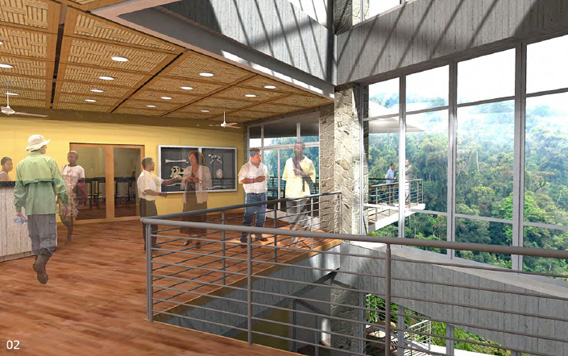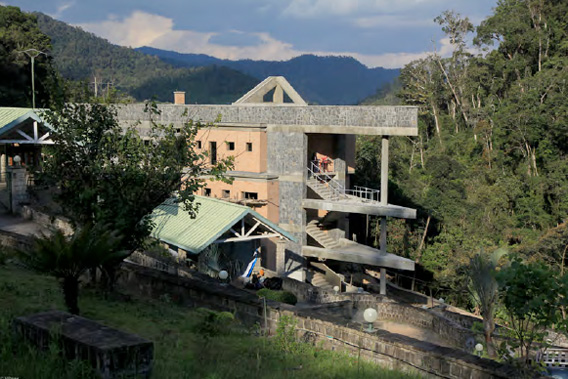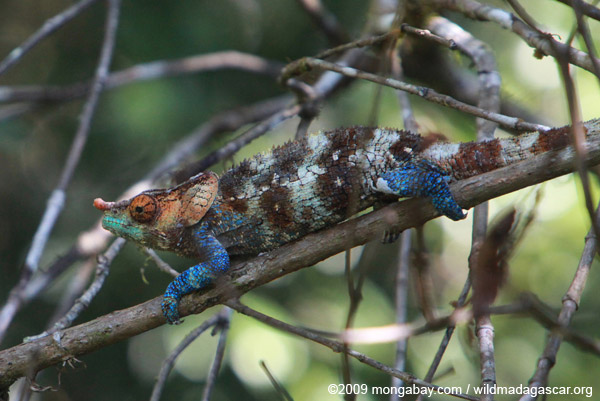
Mockup of the NamanaBe Hall.
A high-tech research center opened today on the edge of a rainforest in Madagascar.
The facility, known as the Centre Valbio, will support efforts to study Madagascar’s unique wildlife, deliver health care to impoverished communities, and understand links between the environment and the rural economy. The project was led by Patricia Wright, a Stony Brook University biologist whose 1986 discovery of the golden bamboo lemur led to the protection of a large swathe of rainforest known as Ranomafana. The park has since become a model for conservation across Madagascar and other parts of Africa.
Work on Centre Valbio began nearly a decade ago and culminated this week with the completion of NamanaBe Hall, a 15,500 square foot (1440 square meter) building that houses a scientific laboratory outfitted to study biodiversity and infectious diseases. NamanaBe Hall employs ‘green’ design and construction, including use of local materials, renewable energy, waste-water management, natural cooling, and roof-top gardens. Unusually for rural Madagascar, Centre Valbio has high-speed internet access.
The facility’s inauguration featured a performance by the Grammy-award winning Malagasy brand Tarika Be as well as the awarding of the Commander National Medal of Honor to Dr. Wright for her scientific achievement.

The new NamanaBe Hall.
Centre Valbio is expected to become a hub for scientific research in Madagascar, which is one of the world’s poorest, yet most biologically diverse countries. The region around Centre Valbio and Ranomafana exemplifies some of the broader challenges facing conservation and sustainable development in Madagascar. While Ranomafana itself is well-protected, in neighboring areas, poor farmers routinely clear forests for subsistence agriculture and cattle grazing, informal miners and loggers exploit gold and valuable hardwoods, and poachers hunt endangered wildlife. Wright and other conservationists hope to take the Ranofamana model, where livelihoods are derived from ecotourism and related activities, and apply it in other areas, boosting local incomes and access to healthcare as well as protection of wildlife and ecosystems.
The forests of eastern Madagascar are particularly rich. Ranomafana is home to more than a dozen species of lemurs and other oddities like the aquatic tenrec and the puma-like fossa. More than 115 species of birds, 100 species of frogs, and 60 species of reptiles are found in the park. Dozens of unknown species have been documented by scientists during the past decade in Ranomafana. The new facility should speed scientific discovery as well as bolster more than two decades of socioeconomic research.

Chameleon in Ranomafana
Related articles
Conservation is saving lemurs and helping people in Madagascar

(05/07/2007) Madagascar, an island nation that lies off the coast of southeastern Africa, has long been famous for its unique and diverse species of wildlife, especially lemurs–primates found nowhere else on the planet. In recent years, the island country has also become world-renowned for conservation efforts that are succeeding in spite of extraordinary pressures from a poor population that relies heavily on forest burning for basic subsistence. A large part of this success is due to the early efforts of Patricia Wright, a primatologist who has been working in the country for more than 20 years. Wright led the effort to launch the country’s leading protected area and helped Madagascar become a leading global example of conservation despite its economic adversity.